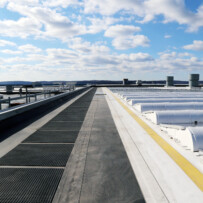
In April 2016, a 24-year old roofing worker died on the job due to the failure of his employer to have adequate fall protection and training, according to federal investigators. Unfortunately, he was not alone. Falls are the leading cause of death in the construction industry. According to the Bureau of Labor Statistics, the fatal work injury rate for roofers in 2014 was 46.2 per 100,000 full-time equivalent (FTE) workers.
The Occupational Safety and Health Administration (OSHA) takes this issue seriously and will cite and fine roofing companies for failure to provide adequate fall protection. Just to name a few, on September 8, 2016, OSHA cited an Ohio company with proposed penalties of $94,064; on August 15, 2016, OSHA cited a Texas company with proposed penalties of $107,785; and on August 1, 2016, OHSA cited a Massachusetts company with proposed penalties of $124,960.
What are the OHSA Requirements?
29 CFR 1925.501(b) (10) applies specifically to roofing work on low-slope roofs. It says workers engaging in roofing activities on low-slope roofs, with unprotected sides and edges 6 feet (1.8 m) or more above lower levels, must be protected from falling by:
- Guardrail systems
- Safety net systems
- Personal fall arrest systems, or
- A combination of a warning line system and guardrail system, a warning line system and safety net system, a warning line system and personal fall arrest system, or a warning line system and safety monitoring system. On roofs 50 feet (15.25 m) or less in width the use of a safety monitoring system alone without the warning line system is permitted.
29 CFR 1926.501(b) (11) applies specifically to working on steep roofs. It says each employee on a steep roof with unprotected sides and edges 6 feet (1.8 m) or more above lower levels must be protected from falling by guardrail systems with:
- Toeboards
- Safety net systems, or
- Personal fall arrest systems.
However, it is not enough just to have fall protection in place. According to 29 CFR 1926.503, employers must provide fall protection training to workers who might be exposed to fall hazards. The worker must be trained to not only recognize the hazards of falling, but also on the procedures to minimize them. A written training certification record must be kept. See 29 CFR 1926.503 for details.
Of course, these are not the only fall protection-related OHSA requirements. A good resource on the subject is OHSA’s “Fall Protection in Construction” publication. Many injuries and deaths can be prevented if everyone takes fall protection seriously.
